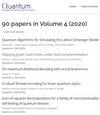Stochastic Thermodynamics at the Quantum-Classical Boundary: A Self-Consistent Framework Based on Adiabatic-Response Theory
IF 5.1
2区 物理与天体物理
Q1 PHYSICS, MULTIDISCIPLINARY
引用次数: 0
Abstract
Microscopic thermal machines promise to play an important role in future quantum technologies. Making such devices widely applicable will require effective strategies to channel their output into easily accessible storage systems like classical degrees of freedom. Here, we develop a self-consistent theoretical framework that makes it possible to model such quantum-classical hybrid devices in a thermodynamically consistent manner. Our approach is based on the assumption that the quantum part of the device is subject to strong decoherence and dissipation induced by a thermal reservoir. Due to the ensuing separation of time scales between slowly evolving classical and fast relaxing quantum degrees of freedom, the dynamics of the hybrid system can be described by means of adiabatic-response theory. We show that, upon including fluctuations in a minimally consistent way, the resulting equations of motion can be equipped with a first and second law, both on the ensemble level and on the level of individual trajectories of the classical part of the system, where thermodynamic quantities like heat and work become stochastic variables. As an application of our theory, we work out a physically transparent model of a quantum-classical hybrid engine, whose working system consists of a chain of Rydberg atoms, which is confined in an optical cavity and driven by periodic temperature variations. We demonstrate through numerical simulations that the engine can sustain periodic oscillations of a movable mirror, which acts as a classical load, against external friction and extract the full distributions of input heat and output work. By making the statistics of thermodynamic processes in quantum-classical hybrid systems accessible without the need to further specify a measurement protocol, our work contributes to bridging the long-standing gap between classical and quantum stochastic thermodynamics.量子-经典边界的随机热力学:基于绝热响应理论的自洽框架
微观热机有望在未来的量子技术中发挥重要作用。要使这类设备得到广泛应用,就必须采取有效策略,将其输出导入经典自由度等易于访问的存储系统。在这里,我们建立了一个自洽的理论框架,从而有可能以热力学一致的方式为这种量子-经典混合设备建模。我们的方法基于这样一个假设:器件的量子部分会受到热库诱导的强烈退相干和耗散。由于缓慢演化的经典自由度和快速弛豫的量子自由度之间的时间尺度随之分离,混合系统的动力学可以通过绝热响应理论来描述。我们的研究表明,在以最小一致的方式将波动包含在内后,所得到的运动方程可以配备第一和第二定律,无论是在集合层面上,还是在系统经典部分的单个轨迹层面上,热力学量(如热和功)都成为随机变量。作为我们理论的应用,我们建立了一个物理上透明的量子-经典混合引擎模型,其工作系统由一连串的雷德贝格原子组成,这些原子被限制在一个光腔中,并由周期性的温度变化驱动。我们通过数值模拟证明,该发动机可以在外部摩擦的作用下维持作为经典负载的可移动镜子的周期性振荡,并提取输入热量和输出功的完整分布。我们的工作使量子经典混合系统中的热力学过程统计变得容易获得,而无需进一步指定测量协议,从而有助于弥合经典与量子随机热力学之间长期存在的鸿沟。
本文章由计算机程序翻译,如有差异,请以英文原文为准。
求助全文
约1分钟内获得全文
求助全文
来源期刊

Quantum
Physics and Astronomy-Physics and Astronomy (miscellaneous)
CiteScore
9.20
自引率
10.90%
发文量
241
审稿时长
16 weeks
期刊介绍:
Quantum is an open-access peer-reviewed journal for quantum science and related fields. Quantum is non-profit and community-run: an effort by researchers and for researchers to make science more open and publishing more transparent and efficient.
 求助内容:
求助内容: 应助结果提醒方式:
应助结果提醒方式:


